Discover 3 Levels Of Geo Targeting For Beginners, Intermediates, & Experts

In paid search, setting geographic targets is day one. Whether it’s to exclude places you cannot sell or serve or to specifically target your primary customer base, the implementation of geo-targets is on the must-do list for a proper PPC campaign.
Having cleared that up, we’re now onto the next layer of questions:
- Intro: How to I create this kind of targeting?
- Intermediate: What kind of geo-targeting should I use?
- Expert: How can I “advance” my geo-targeting strategies?
Introduction
We’ll begin with Google and Bing campaigns, as they’re often the most common types of paid search campaigns you’ll start with.
Within each platform, you’ll find a Settings tab that provides control over each campaign’s geographic targets. At this time, location targeting can only be set at the campaign level. Below is a view of how it appears in Google.

If you’re creating your geo-targets for the first time, select a campaign you’d like to adjust. You’ll then choose the “+ Locations” button which looks like this:

From here a window will pop up where you can select just which areas to target.
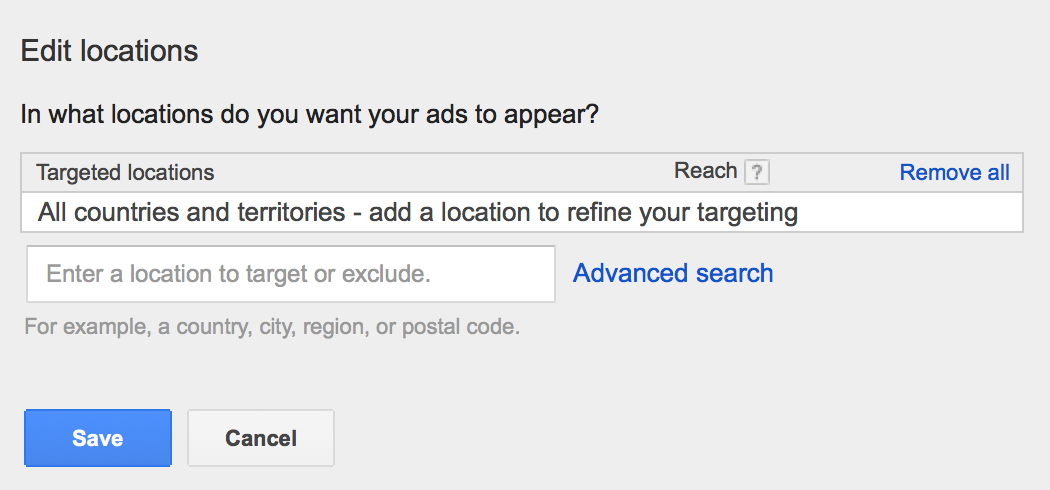
Unless you copy this campaign from one with some sort of existing targeting, the campaign will automatically target the entire planet.
Repeat: Failing to adjust your location targeting will pull in traffic from everywhere.
So step one is narrowing this target by either selecting a location, such as Orlando, Florida.
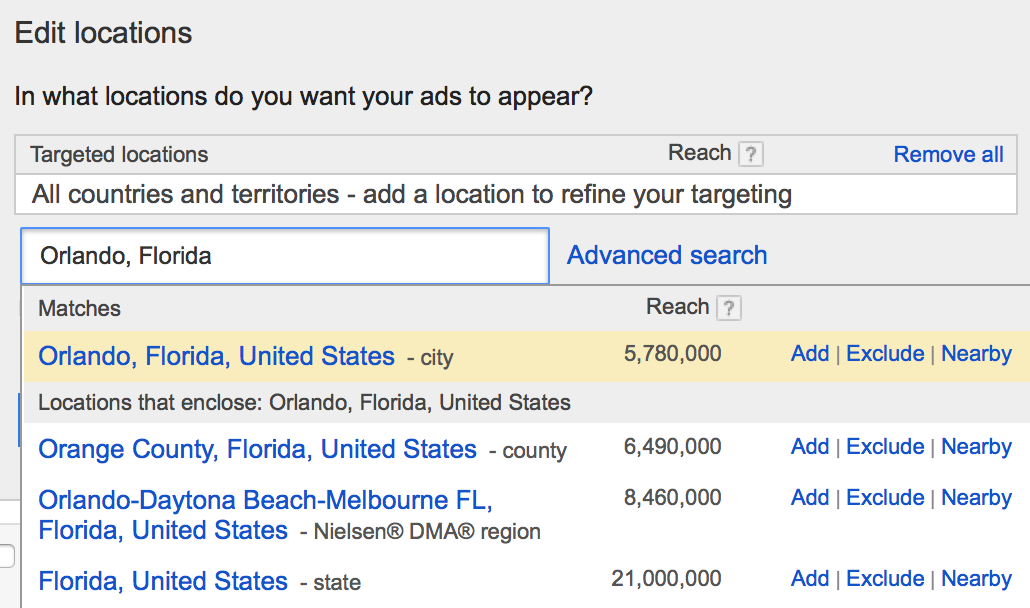
Or excluding the locations you know you won’t be able to service or sell to, such as Alaska and Hawaii.
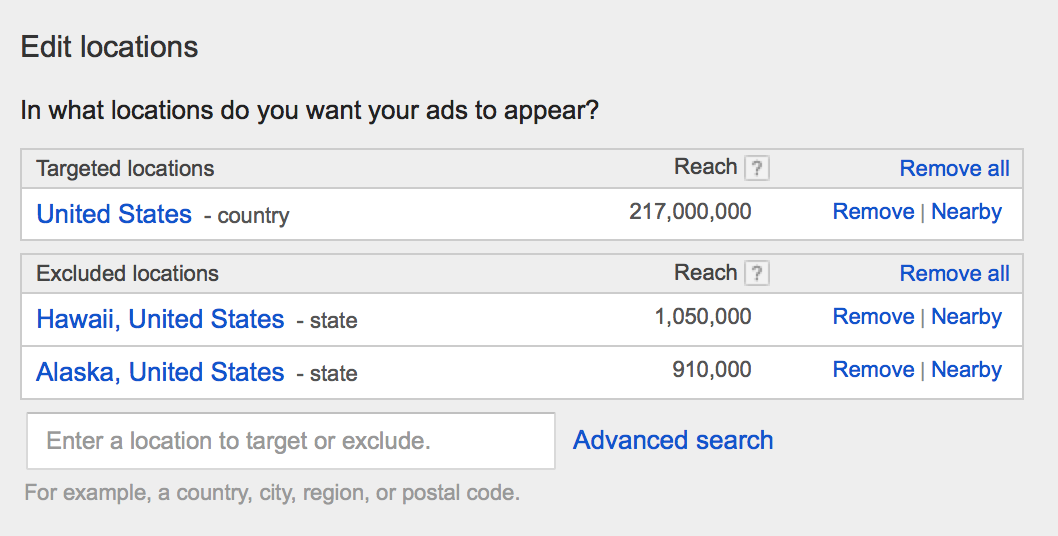
The best news is that you can go through virtually the same steps for Bing:
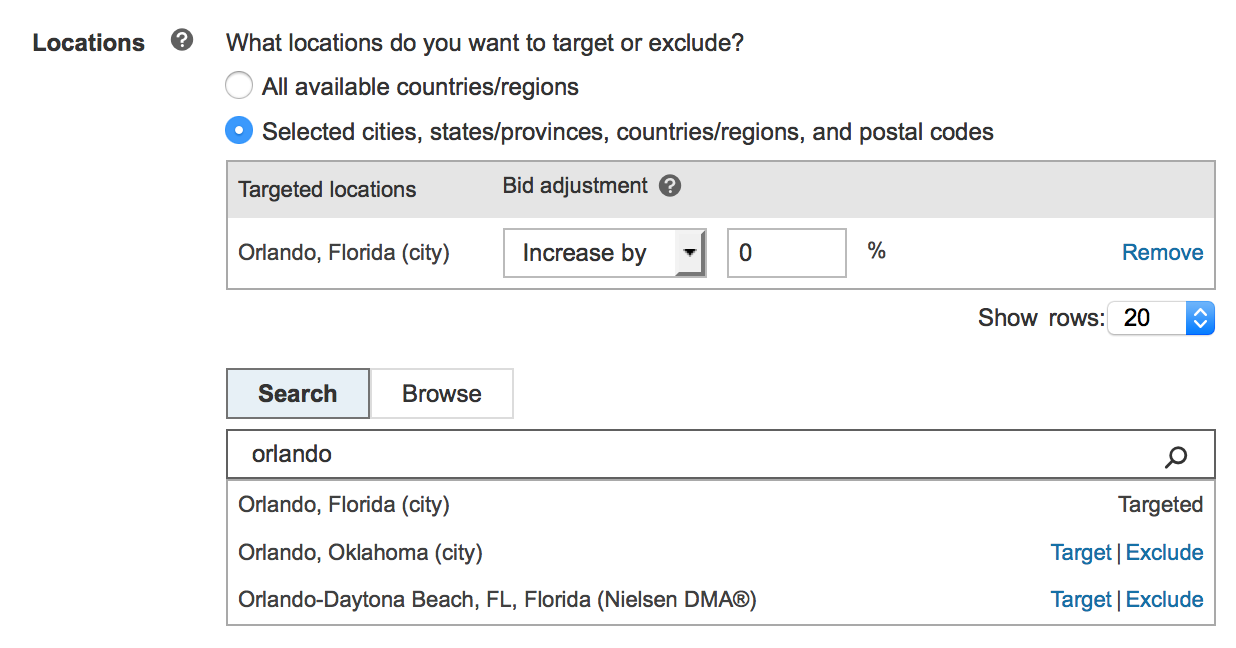

Now before you sign off on geo-targeting as a freshly trained grasshopper, you’ll want to be intentional about whom these residents are. In the above example, we opted to target Orlando. Google and Bing both give you the option of targeting folks who are literally in Orlando or those who’ve simply shown interest in Orlando through their previous search history, or both – pretty much anyone in or aware of happenings in Orlando.

Note: This strategy can also be applied to most platforms, such as Facebook.
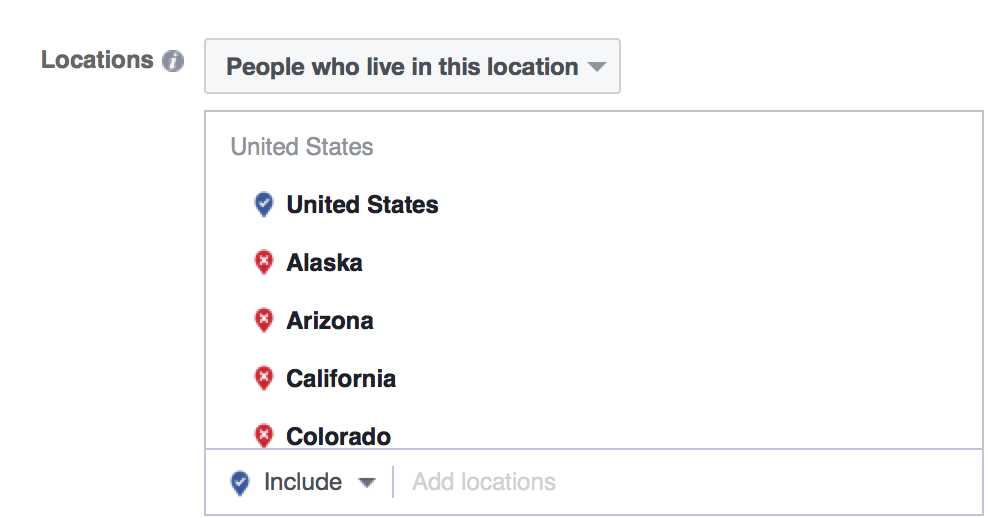
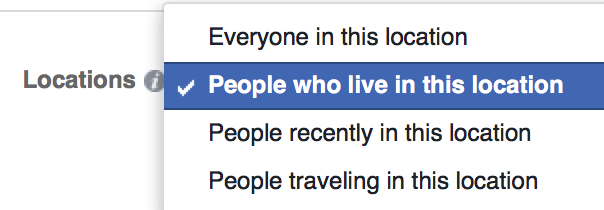
The final layer to setting up geo-targeting is utilizing a bid modifier to tell Google and Bing to bid slightly higher on traffic that falls within specific locations you’ve noted, such as targeting the whole state of Florida, with special emphasis on Orlando-eans:
Google’s setup:
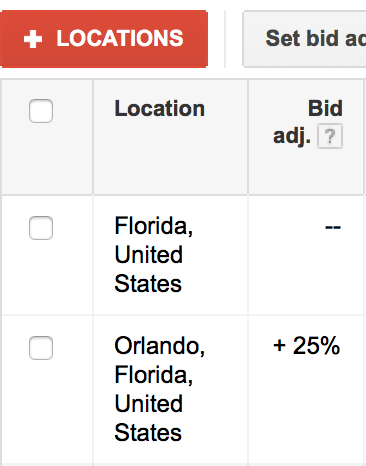
Bing’s setup:

Now many folks find that when they have highly intentional geographic targeting, things would be best segmented at the campaign level, meaning creating geo-specific campaigns.
Intermediate
It’s likely if you consider yourself an intermediate PPC Hero, you’re familiar with this step. Well done, friend. This means we’re ready to talk about what kind of geo-targeting makes the most sense for you. To assess this, you must do two things.
- Make sure you’re pulling data from any geographic region you’re considering. For example, I noted in the above paragraph that I may end up targeting Orlando through refined targeting or even one of them fancy schmancy bid modifiers. But unless I’m actually pulling in Orlando’s traffic, I don’t know how it’s performing for PPC. Hence, I opt in with the next step being optimizing.
- You can’t optimize without a report, which is Step 2. Pulling a report for the geo targets you have set can occur in a few places, which we’ll cover below.
Google option A: In the location targeting tab itself. Remember how we set the geo targets in the settings tab? Google now lets us pull performance data from that very page, with a variety of segments.

If you’re targeting just one or the other, it’s a no-brainer. If you’re targeting all users, this reports tell you different stories. Because I’m a purist by nature, I’d recommend looking at those who are located (by self-admission or by Google’s best guess) within your targeted region.
Here is Google’s take on how your ads performed by ZIP (or postal) code.
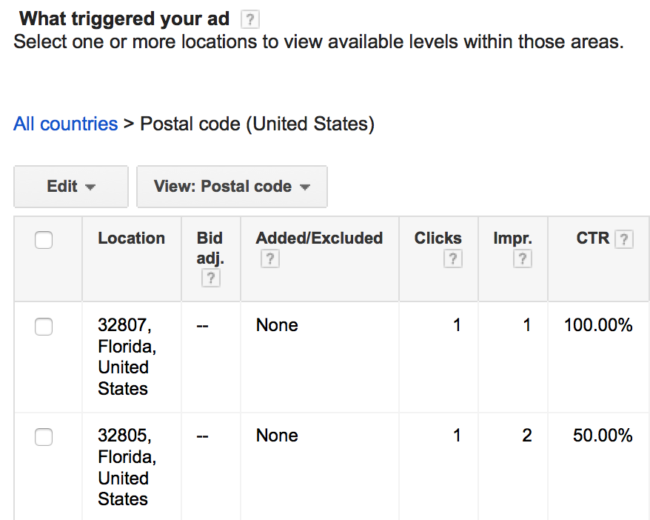
Below is an example report at the “City” level.
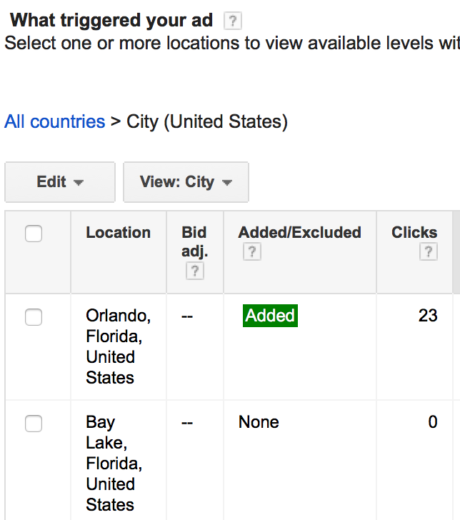
You then can select what data to pull into your report. As a personal preference, the limited reported capabilities of this tab (providing just the segment you request) has me looking to my Dimensions tab instead.
Google option B is the Dimensions tab of the AdWords interface, where you can not only choose the type of report, but also the columns of detail.
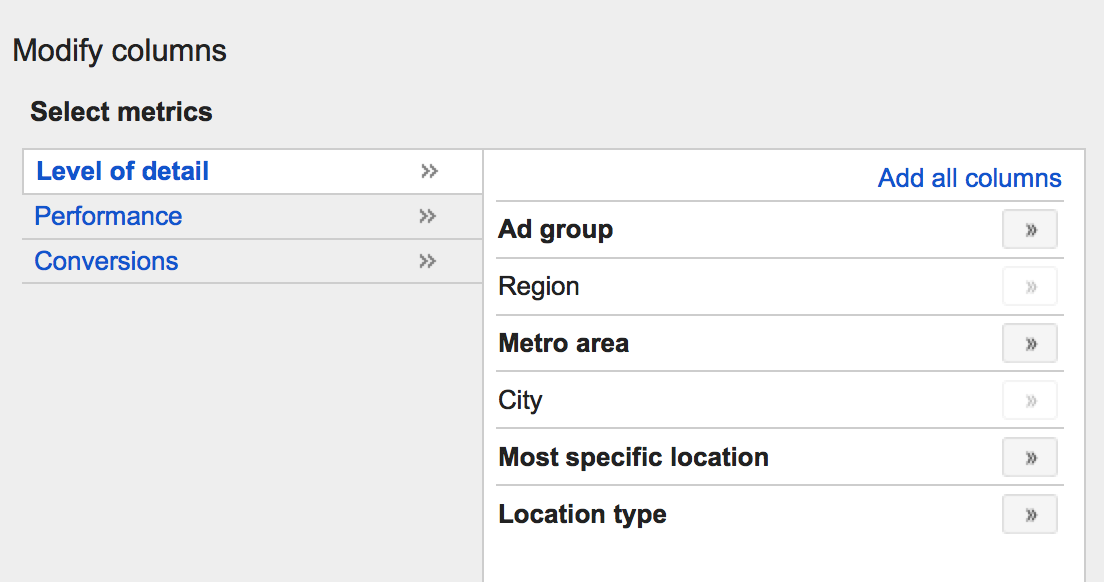
By adding in the highest level of detail, I can see when certain ZIP codes or municipalities pop up in my data, as shown below.
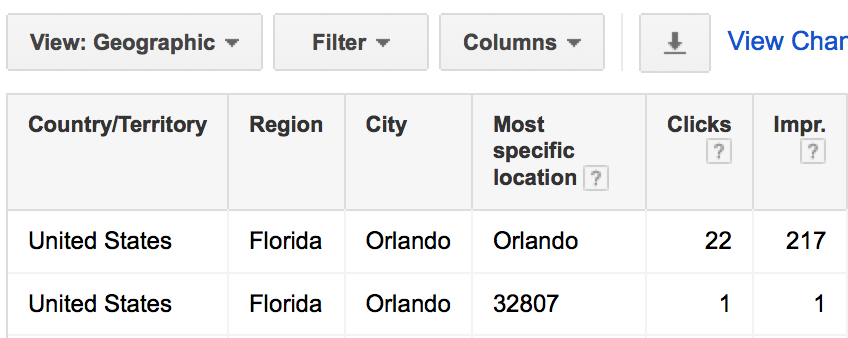
Now that you have your data – what do you do with it? Typically your first step, like most things PPC, is to pull back on what’s performing poorly or inefficiently and to push up on that which does well.
Commonly we refer to this formula for tips on creating a well-calculated bid modifier:
Geo Bid Multiplier = (Avg. Campaign CPA / Geo CPA) – 1
If you’re working off engagement data only, using a combination of CTR and CPC will get you to a desired bid adjustment as well.
Adjusting your geo bid modifiers can help sort out the areas where strengths and weaknesses lie.
Bonus: To add a layer of complexity to your targeting, consider using Google’s income targeting as a geo-target. Again, be sure to include all targets at a 0% bid adjustment so that the data populates fully. Once this has generated statistically significant volume, take a look at what came through.

We were certainly expecting that the high-income targets would be our best customers for this particular account, but what we experienced was an odd mix of extremely high volume in the lower sectors to be often followed by high-income audiences. Demographic “user profiles” aside, the numbers are telling us with whom we’re resonating. From here we identify who our best bets are and implement adjustments based on these data.
Experts
Alright, you’ve seen these tricks before, have you? Well, let’s see if we can’t push the envelope a bit further then. To do this, we’ll walk through additional targeting and geo-layering options.
So you’ve set up your geo targets but what do we also know about paid search? It’s rarely complete without a good old remarketing list!
To take your geo-targeting to the next level, consider how you might marry these two targets. Your best choices are:
- Retargeting lists based on the campaign that generated the click. Example: I brought visitors to my site using an Orlando-only campaign. I then create a remarketing list in GA for those specific users:
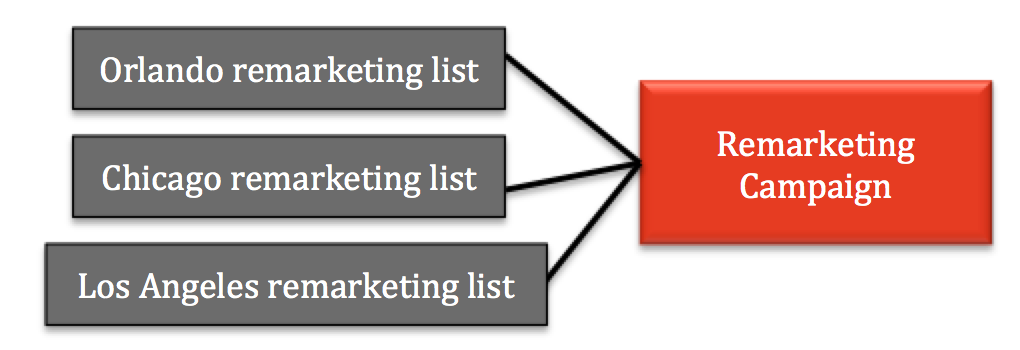
This allows me to speak directly to those who’ve come through my website as residents/travelers/enthusiasts of that geo-target. My retargeting message them speaks to this familiarity as well as the intentional “Oh, still looking?” message I’ll tie in.
The benefit to this approach is that not only is this a controlled list, but you’re also able to put all of these geo-targeting audiences in a single campaign. But you’re thinking: How can that be? I can’t set geo targets at the ad group level? How can I put my Orlando audience and my Chicago audience in the same campaign without mixing up all this targeting? Your single campaign with only remarketing lists from only pre-approved geo-targeted campaigns placed lovingly into their own ad groups needs no hyper-specific geo-targeting. The remarketing lists are all the restrictions you need and because your ads are created at the ad group level, you’re detailed message remains intact.
2) The second option is to simply create a remarketing campaign and confine it to your geo-restricted campaign:

This assists in limiting your reach to only those on your geo-specific list thru the campaign settings. The upside to this method is that you have more budget control, particularly if you have spend allotted by geographic market. You also have access to a larger pool of returning visitors who may or may not have been properly geotargeted in the first place. The downside is that you now have this many more campaigns to manage, optimize and develop strategies for. (Reminder: Fear of additional campaigns shouldn’t dictate your campaign structure, friends. Efficiency should be a consideration but not the guiding factor.)
Your final Expert Advice for geotargeting goes out to those with storefronts and offices across a variety of locations. Although we expect that you will create your geo-targets based on these regions, an added layer of geo-bidding can assist in reaching those on the outskirts.
For example, were we to have a campaign targeting a branch out of New Orleans, a radius-layered geo-target (centered on the office location’s zip code) would appear as such in Google AdWords.
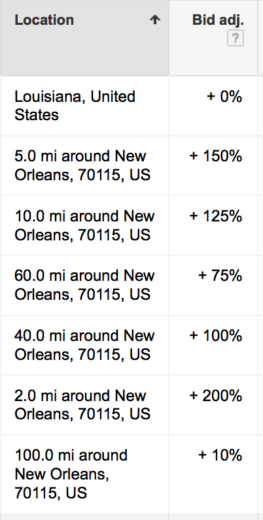
The goal with this type of targeting is to ensure that we reach relevant audiences for online purchasing opportunities, but at the same time promote brand awareness for our shop.
The impact of the targeting then has an effect similar to the one listed below.

Again, the concept of geo-targeting should not be a new one to you mighty PPC Heroes, but the way you utilize the opportunities within the targeting tools can not only separate you from your competitor but also assist in improving your reach and your results.



